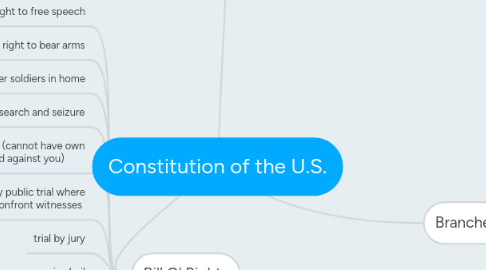
1. History
1.1. Locke
1.1.1. Thinker of the late 1400s and early 1500s who is one of the fathers of social contract theory. A liberal thinker who theorized a proto-capitalist society where individuals formed government around a common concern for solving issues surrounding private property. His conceptions of government inform our own.
1.2. Magna Carta
1.2.1. Document written in 1215 by feudal barons in England to help curtail the power of the king. They wanted to ensure protection of their rights. Beginning of constitutional monarchy which helped inspire John Locke and our founding fathers.
1.3. Lesson 1:
1.3.1. Students will use a keyword prompt to research on the internet who John Locke was and what the Magna Carta was. They will take notes on the people/document while on their computers that encompass the subjects during their time of relevance as well as events or people that inspired these subjects. Using this knowledge students will being a timeline (to be used in other classes) that notes where the Magna Carta and John Locke fall in time. This will serve as a visual reference point for the development of modern democracy. Students will fill in the vast space between the dates with information from their research that lead to the rise of each of these subjects.
1.4. DOI
1.4.1. July 4 1776. Document that stated America's independence from England. Cited infringements of rights by the King as reason for leaving. Our conception of rights came from Locke's theories as well as others.
1.5. AOC
1.5.1. A precursor to the Constitution. Document that made US a confederacy. Lots of power to the states and the national government was just a body that tied them together. Eventually proven too weak by Shay's Rebellion.
1.6. Lesson 2:
1.6.1. Using their textbooks, students will read about the declaration of independence in groups of 4. 2 students will be assigned to the DOI and two to the AOC. The pairs will take notes on what the documents are, what their implications were, and events the led to their creation. They will then exchange notes with the other students in their group to complete the note set. Students will then return to seats and discuss findings with the teacher. The teacher will record findings on the board and then lecture to fill in any remaining holes. After discussion, students will return to individual work and continue to work on their timelines - adding to what they created in the Locke and Magna carta lesson
2. Branches
2.1. Executive
2.1.1. The body that "leads". This branch houses the leaders of government and the final decision makers. President, VP, Cabinet, foreign diplomats, etc. Outlined by article II
2.2. Legislative
2.2.1. Congress - combined bodies of House of Representatives and Senate. Branch of government charged with writing and voting on the laws of the land. Also control the budget as well as the ability to declare war. Feeds off of liberal/Lockean idea that the rule comes from the people (via elected officials)
2.3. Judicial
2.3.1. Branch of government that determines legality of laws. Is responsible for checking power of Exec. and Legislative branches by holding them accountable to the jobs laid out for them in the Constitution. Home of the Supreme Court (9 justices)
2.4. Lesson:
2.4.1. Students will be clustered into groups of 3 and given a copy of the articles of the constitution. The teacher will lead a brief lecture on the founding and ratification of the Constitution based off of the research previously done on the DOI and AOC. Students will then, in their groups, take notes on the roles of each branch as outlined in the Constitution and the article(s) that accompany the branch. After gathering notes, the groups will use computers to research a branch of their choice and its actions in current politics. Ex: recent judicial ruling on Hobby Lobby. Students will report their findings to the class, explaining how their finding relates to what they found in the document.
3. Bill O' Rights
3.1. Right to free speech
3.2. right to bear arms
3.3. right to not quarter soldiers in home
3.4. safety from unreasonable search and seizure
3.5. miranda rights (cannot have own testimony used against you)
3.6. right to speedy public trial where accused can confront witnesses
3.7. trial by jury
3.8. no excessive bail
3.9. protection for rights not specifically mentioned in constitution (like privacy)
3.10. powers not reserved for federal, and not prohibited for states, are reserved for the states
3.11. Lesson
3.11.1. Students will be lead through a brief discussion of the bill of rights - covering its history and each of the amendments. After being briefed with what the amendments are and handed a list of them, students will be put into teams of 5 and given 10 different scenarios. They will be tasked with deciding if the actions taken in the vignettes abide by the amendments or not and give reasoning why. The class will reconvene and discuss each group's answers and reasons why. Students will then be presented with a court case from real life that applies to each of the rights that were demonstrated in the vignettes for real world connection.

